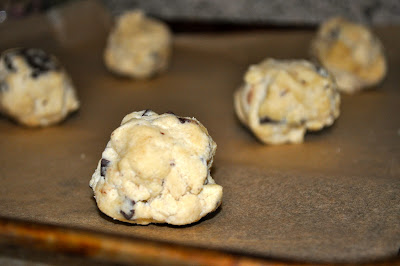I know that many of you are warriors in your own kitchen. You experiment, you play, you conquer. You are the ones who can't wait to cook with new ingredients, use new techniques. You are always excited to try a new recipe, and you are as thrilled by your friends' culinary successes as you are with your own. After all, they will surely share the recipe (as well as the food) with you. But there are also people who don't understand. Some of them are afraid -- they feel unsure of their abilities in the kitchen. Some of them don't feel like they have the time. Some of them don't really want to. Some just prefer the convenience of store-bought foods. After all, why wait four hours for ice-cream when you can go get it now?
That being said, I would like to tell you why I cook. Hopefully, it will encourage you if you have lost your inspiration, or have been too afraid to try. Maybe I can help you overcome your fear of that candy thermometer. Maybe it will just give you some insight into me. There are always the basic reasons: it tastes better, it (often) costs less, you can control the ingredients that go into your food. But there are deeper reasons, the ones that move the making of food from a hobby to something that is…part of me.
The first of these reasons is that I take pride in the quality of food I feed my family and friends. It's not just about tasting good, it's about knowing that I took the time to choose quality ingredients. It's about knowing that I put my self into that food. It's about knowing that I am serving them food that will nourish their bodies as well as their spirits. Food is a powerful thing because it can trigger emotions, it can comfort us, and the flavors we eat are tied to our memories. So I sincerely hope that the food I feed my family and friends is food that fills their bellies, comforts them, and reminds them of good times.
I also enjoy the artistry. Creativity comes in a plethora of forms with the use of a variety of media, including pencils, paint, clay, cloth, and yes, even food. The artistry inherent in a perfectly risen loaf of bread or in the flakiness of the crust of a summer peach pie is just as satisfying as the creation of an exquisite painting -- at least to the artist. Edible art is not to be ignored, and for those of us who cook with the passion of a creative spirit, we are all artists and food is our medium. I hope you never once doubt the creativity of your culinary expeditions. I promise that I won't.
And finally, knowing I can make something like bread or yogurt is freeing. Let me explain: as much as there is a great convenience to purchasing food items in the store, this convenience also manages to inhibit you. It renders you dependent on a store (that may have just run out of the item you really needed), and it leaves you with no backup plan. Now there is absolutely nothing wrong with purchasing the items in your pantry. But there is something so liberating and exciting about knowing that YOU made those items yourself. I don't have to worry about whether or not the grocery store ran out of yogurt because I know how to make it from scratch. Knowing that the bags of granola, loaves of bread, cheese, and jars of jam in my kitchen were all made right here in my kitchen makes me feel invincible. I could make anything. It also ties me to the roots of people who have made these things at home for generations. It gives me this feeling that I have not forgotten that history, and that I am in fact part of it.
Which now brings me to that new book. I stumbled across a fantastic new cookbook, by Alana Chernila, called The Homemade Pantry: 101 Foods You Can Stop Buying and Start Making. Now I don't often buy cookbooks, because I don't have the space. But I couldn't resist with this one. Alana makes home cooking accessible in a fantastically approachable way. She also encourages her readers to branch out and make things at home that they would never usually consider. Homemade ketchup anyone? You may have heard of Alana before. She writes a lovely blog called Eating From the Ground Up, where she writes about food, family, and all the stuff in between.
What I really love about Alana's new book is that she shares her self in it. It's full of stories about her family, stories about her recipes, and she manages to become your friend after a very short introduction. For those of you who are afraid of anything shy of boiling water, or even if you are a seasoned cook who just needs a little inspiration or a little push to try something new, this is your book. Alana will take you on a ride, encouraging you to try projects that are as simple as making pudding or as complex as making cheeses, or canning your own produce. I find that there is something for every cook between those pages, and I am really looking forward to trying all of her recipes. I hope you will, too.
















